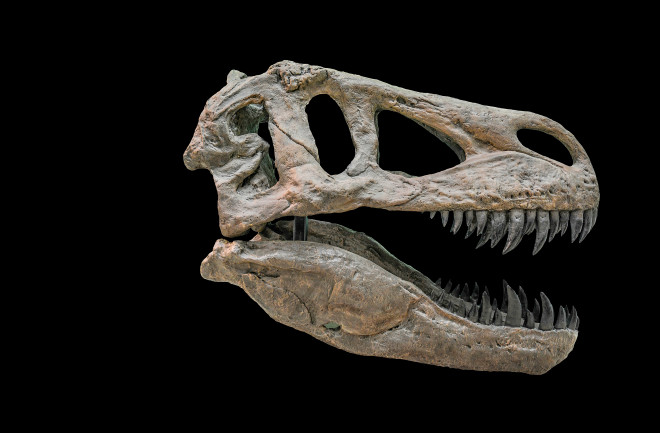Paleontologists know a lot about Tyrannosaurus rex from the abundance of fossilized specimens they’ve found throughout North America. They know, for instance, that the theropod had sharp, serrated teeth, each the size of a banana, and a bite force over a hundred times that of a human. They also know that the species had a huge head, almost 5 feet from front to back. But, in the absence of brain tissue, what was inside that massive skull has remained a mystery.
In a study published in the June 2023 issue of the Journal of Comparative Neurology, Suzana Herculano-Houzel, a neuroscientist and associate professor of psychology at Vanderbilt University, took a controversial first stab at calculating the neuronal count of several species of dinosaur, including T. rex.
How Can You Measure Brain Mass?
Neuronal numbers are difficult to determine without brain tissue, though they aren’t impossible to approximate in modern species, since there are scalable relationships between an animal’s brain mass and number of neurons that differ depending on the animal.
The scalable relationships for birds can estimate the neuron count of a sparrow, for instance, while the scalable relationships for reptiles can estimate the neuron count of a snake. Armed with that wisdom, Herculano-Houzel set out to estimate the neuronal numbers of Tyrannosaurus, based off the neuronal scaling rules of the theropod’s distant, modern-day relatives.
What Is the Brain Mass of the T. rex?
Comparing the brain mass of T. rex (extrapolated using the shape and size of its brain cavity) with the brain masses of birds and reptiles, she found that T. rex and ostrich brains were similarly sized in comparison to their bodies. From this, she surmised that the theropod followed a similar set of scaling rules as ostriches and ostrich-related birds. Using those birds as a guide, she then developed a set of scaling equations, which would supposedly estimate the dinosaur’s neuronal composition.
Herculano-Houzel’s calculations suggested that the theropod carried over 3 billion neurons in its cerebrum — a neuron count similar to a baboon.
“The study showed that T. rex, along with other theropods, were the primates of their time,” she speculates, adding that the theropod may have been capable of the same complex cognition that allows primates to produce tools and pass knowledge to offspring. “T. rex had what it takes,” she adds, though it isn’t clear whether the species would’ve used its brains for those particular activities.
How Smart Was the T. rex?
The research is an impressive attempt to quantify the intelligence of a species from 66 million years ago, says Amy Balanoff, a paleontologist at Johns Hopkins University not involved in the study, “but the author uses too broad of a brushstroke when trying to estimate the [theropod’s] brain mass.”
Failing to account for a sinus that did not contain brain tissue inside the Tyrannosaurus skull, Herculano-Houzel’s equations may have assumed a greater similarity between T. rex and ostrich brains than truly exists, potentially throwing off the neuron estimates.
Ashley Morhardt, a paleoneurologist at Washington University School of Medicine in St. Louis, has her own concerns about the approach. Not only is it possible that the equations over- or underestimated the number of neurons in the T. rex brain, but there’s also no way to verify the truth of their estimations.
“It’s never been done before,” she says, and “because of the fact that … soft tissues at the neuronal level don’t fossilize, there’s no way for us to ground truth it.”
Both Balanoff and Morhardt argue that the baboon comparison is a stretch, but Balanoff believes the research is promising for future studies of T. rex smarts.
“It’s given us the idea that maybe this is possible,” Balanoff says. “We might, at some point, get to an estimation of neurons.” Until then, all that’s safe to say is that Tyrannosaurus was as smart as it needed to be, whether the theropod was on par with modern primates or not.
This story was originally published in our January/February 2024 issue. Click here to subscribe to read more stories like this one.

